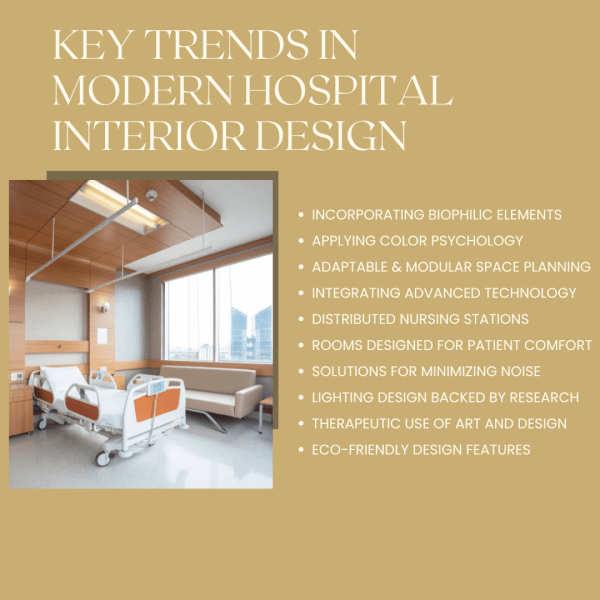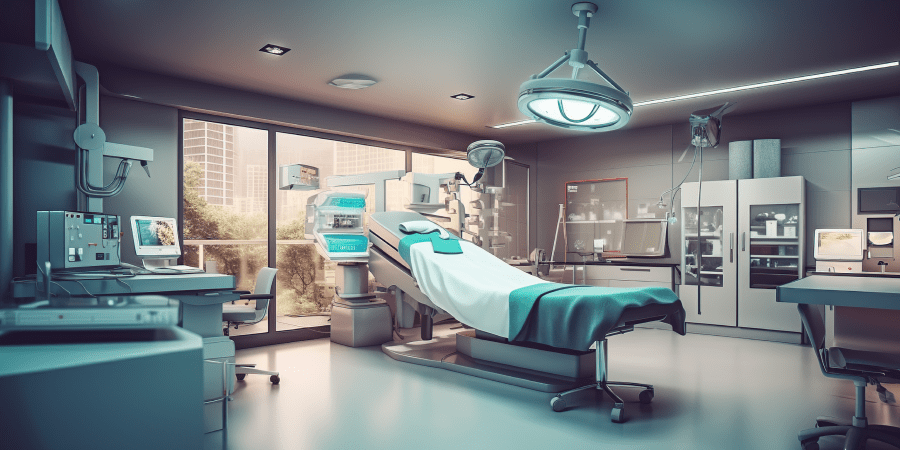In today’s world, we’re all looking for ways to be...
We all need to visit a hospital at some point in our lives, but there are many patients who are dealing with serious health. For them, hospitals become a temporary home, as they may spend days or even weeks away from the comfort of their own homes. The often cold environment of the hospital can make them feel more isolated, impacting their recovery. When a patient is in hospital for a long time, the hospital’s interior feels cold or impersonal, and adds the stress that both patients and their families experience. This is why creating hospital spaces that feel welcoming and warm is so important. Simple changes to the interior can help reduce stress, improve privacy, and boost mood, making a real difference in the healing process.
When you’re updated with the latest trends in hospital design, you can ensure that spaces are not only comfortable and safe but also meet the needs of modern patient care. In this blog, we’ll explore the top ten hospital interior design trends that can enhance patient comfort, improve staff efficiency, and create a better overall environment. From natural elements to flexible layouts, these design strategies are helping hospitals become spaces that prioritize complete well-being.
Key Trends in Modern Hospital Interior Design
Modern hospital interior design is evolving to create environments that prioritize the well-being of both patients and staff. As healthcare spaces continue to adapt to the needs of today’s world, design trends are focusing on comfort, flexibility, and sustainability. These trends aim to improve patient recovery, enhance staff efficiency, and create more welcoming and healing environments. Here are some key trends shaping the future of hospital interior design:

1. Incorporating Biophilic Elements
Biophilic designs are about adding natural elements in hospital interiors. It is because patients feel better when they are surrounded by natural elements, as nature has a calming effect and helps them reduce stress and anxiety. When you include plants, natural light and views of outdoor green space in hospital design plans, it can create environments that promote healing. Design a space where you can enjoy natural light as it helps improve sleep, boost mood, and support overall well-being. Plants and greenery make hospital spaces feel less sterile and more peaceful, while views of nature can help lower blood pressure and reduce pain, speeding up recovery. Biophilic design not only aids physical healing but also supports mental health, turning hospitals into more comforting and welcoming spaces.
2. Applying Color Psychology
Colors have a great impact on our lives, especially on a sick person. The right colors can influence how we feel and even affect our healing process. There are certain colors that will help you to create a calm atmosphere, reduce anxiety, and can even ease pain. You can add shades of blue and green as these colors are known to have a soothing, healing effect, making them perfect for patient rooms and treatment areas. Warmer colors like red and orange can increase energy and focus, which makes them ideal for staff areas. When you pay attention in choosing colors that suit the needs of a hospital, you can create a space that improves patient well-being and contributes to a better overall experience.
3. Adaptable and Modular Space Planning
Hospitals are always a busy place as they need to handle a variety of services, technologies, and workflows that change over time. This is why you should use flexible, modular designs, as they can easily adjust to new needs and functions. During your hospital planning and designing you can add features like movable walls and adjustable furniture to quickly change the layout with minimal disruption. This flexibility is important for changing or adding departments, updating equipment, and adjusting how work is done. Modular designs also make the best use of available space, and help hospitals to maximize every square foot. This flexibility is important in emergencies or crises when hospitals need to quickly expand or change spaces.
4. Integrating Advanced Technology
The use of advanced technology is essential in modern hospital designs as it improves patient care and simplifies daily operations. In today’s tech-driven era, telemedicine setups, smart patient rooms, and touchless controls are becoming standard features in many hospitals. Adding elements like automated lighting, centralized controls, and digital tools enhances patient safety while helping staff work more efficiently. There are also tools like AI systems that monitor patients, reduce mistakes, and save time. These improvements let doctors and nurses spend more time caring for patients. Sharing data in real time between departments helps teams work better together and make faster decisions.
5. Distributed Nursing Stations
For the convenience of patients, it’s good to place nursing stations closer to patient rooms. This will help nurses to respond quickly to emergencies and give more focused care. This design reduces the time nurses spend walking around, and helps them to concentrate on their tasks. When you have nursing stations spread it also helps create a quieter hospital by spreading out activity, which benefits both patients and staff. It keeps things running smoothly and reduces crowding in busy areas, making the hospital feel more organized. This approach can improve the patient experience too. With smaller groups of patients to manage, nurses can provide more personalized care and stay in closer touch with patients, making communication easier and more effective.
6. Rooms Designed for Patient Comfort
You should design hospital rooms to keep patients comfortable while still being practical for medical care. For this, you can use large windows with automatic blinds so patients can get natural light and have control over their space. To create more space in the hospital design plan, you can add wooden panels and can hide medical equipment behind these panels to keep the room neat and easily accessible. In bathrooms, use non-slip floors for patient safety and comfort. Custom lighting helps patients adjust the brightness according to their convenience. Incorporate family areas with sleeper sofas, charging stations, and small workspaces for added convenience. For more convenience, use smart storage to keep everything organized and the room clean.
7. Solutions for Minimizing Noise
Minimizing noise in hospital design is important because it affects both patient recovery and staff performance. Hospitals can be noisy due to beeping equipment, staff conversations, and people moving around. This noise can disturb patients’ sleep, increase stress, and slow down healing. When redesigning your hospital, focus on reducing noise to create a calmer and quieter environment that helps patients rest and recover better. Less noise also allows staff to stay focused and work more efficiently with fewer distractions. To minimize noise, use soundproof materials like acoustic panels and special flooring. Adding sound-insulating walls in patient rooms helps maintain a peaceful environment and improves communication between patients and their caregivers.
8. Lighting Design Backed by Research
Lighting plays a crucial role in hospital design because it impacts how well patients heal, how effectively staff perform their jobs, and how smoothly the hospital operates. Soothing lights make the space feel calm and welcoming, helping patients and their families feel less stressed. Good lighting also supports patients’ natural sleep patterns, aiding in better rest and faster recovery. Bright lighting in focused areas like operating rooms or labs ensures doctors and nurses can see clearly, reducing the chance of mistakes. In patient rooms and waiting areas, softer, adjustable lighting creates a relaxing atmosphere and adapts to different needs throughout the day. Use energy-saving LED lights, motion sensors, and systems that adjust lighting based on daylight improves light quality while also reducing energy costs.
9. Therapeutic Use of Art and Design
Add art to your hospital design by using calm colors, nature-inspired artwork, and thoughtful design elements. When you carefully integrate the art design into the space, they create a positive, stress-relieving environment that promotes mental well-being. Art installations, such as murals or sculptures, can provide visual stimulation and help distract patients from their medical conditions, reducing anxiety. You can also incorporate natural elements, like plants or views of outdoor landscapes, which can further aid relaxation. In patient rooms and common areas, add designs with soothing textures, patterns, and lighting contribute to a more comfortable atmosphere.
10. Eco-Friendly Design Features
Eco-friendly designs reduce the hospital’s environmental impact, which is increasingly important today. When you use sustainable materials for hospitals, (like energy-efficient lighting, solar panels, and good insulation) you can lower energy use and cut utility costs. Hospitals can use these savings to improve patient care and hospital services. Use eco-friendly materials, like non-toxic paints, natural flooring, and low-emission furniture as it helps improve indoor air quality in hospitals. This benefits the environment and promotes the health of patients, staff, and visitors by reducing harmful chemicals. You can also add green spaces to create a calming atmosphere that supports healing and reduces stress.
Transform Your Hospital Design With Inner Value Architects
The interior design of hospitals plays a critical role in both the comfort of patients and the efficiency of healthcare staff. When you incorporate the above-mentioned points in your hospital design, you create an environment that promotes healing, reduces stress, and supports the well-being of both patients and staff. A thoughtfully designed space can improve patient recovery times, enhance the overall hospital experience, and boost staff morale and productivity. By focusing on key elements, hospitals can become a modern, functional, and comforting place for all who enter. To ensure your hospital meets the highest standards of design and care, you can consult Inner Value Architects for expert advice and tailored solutions. Our expertise in hospital design creates a balance between look, function, and patient comfort, making the environment healing for both practical use and emotional well-being.










